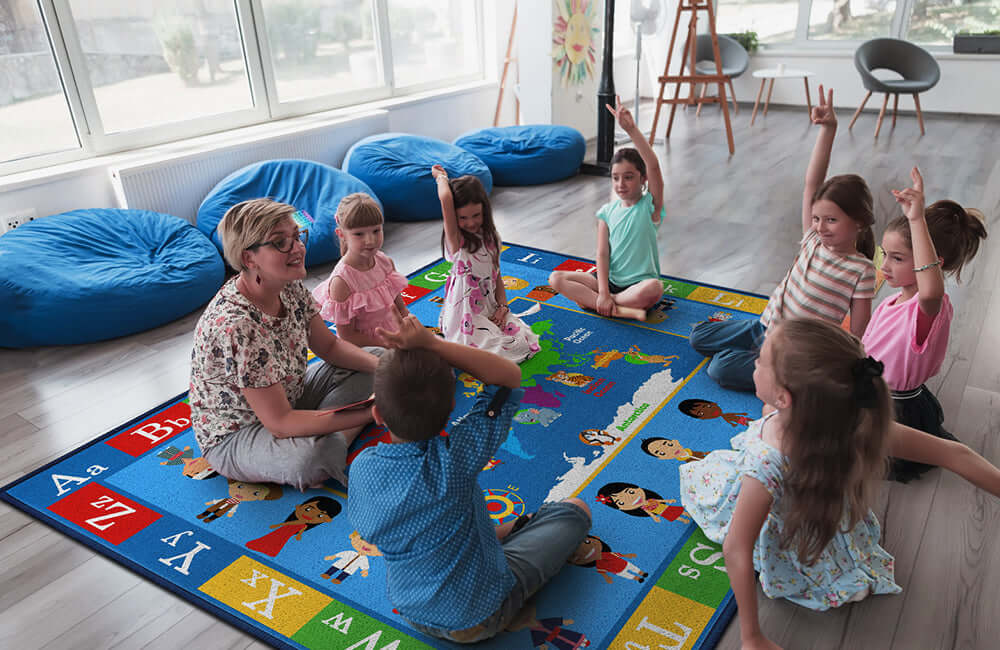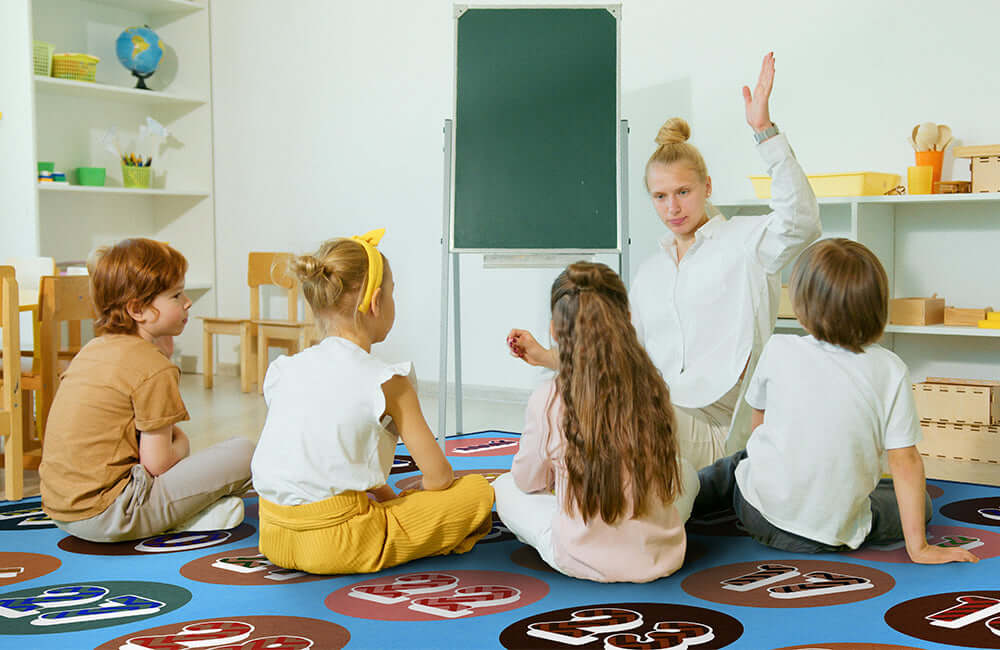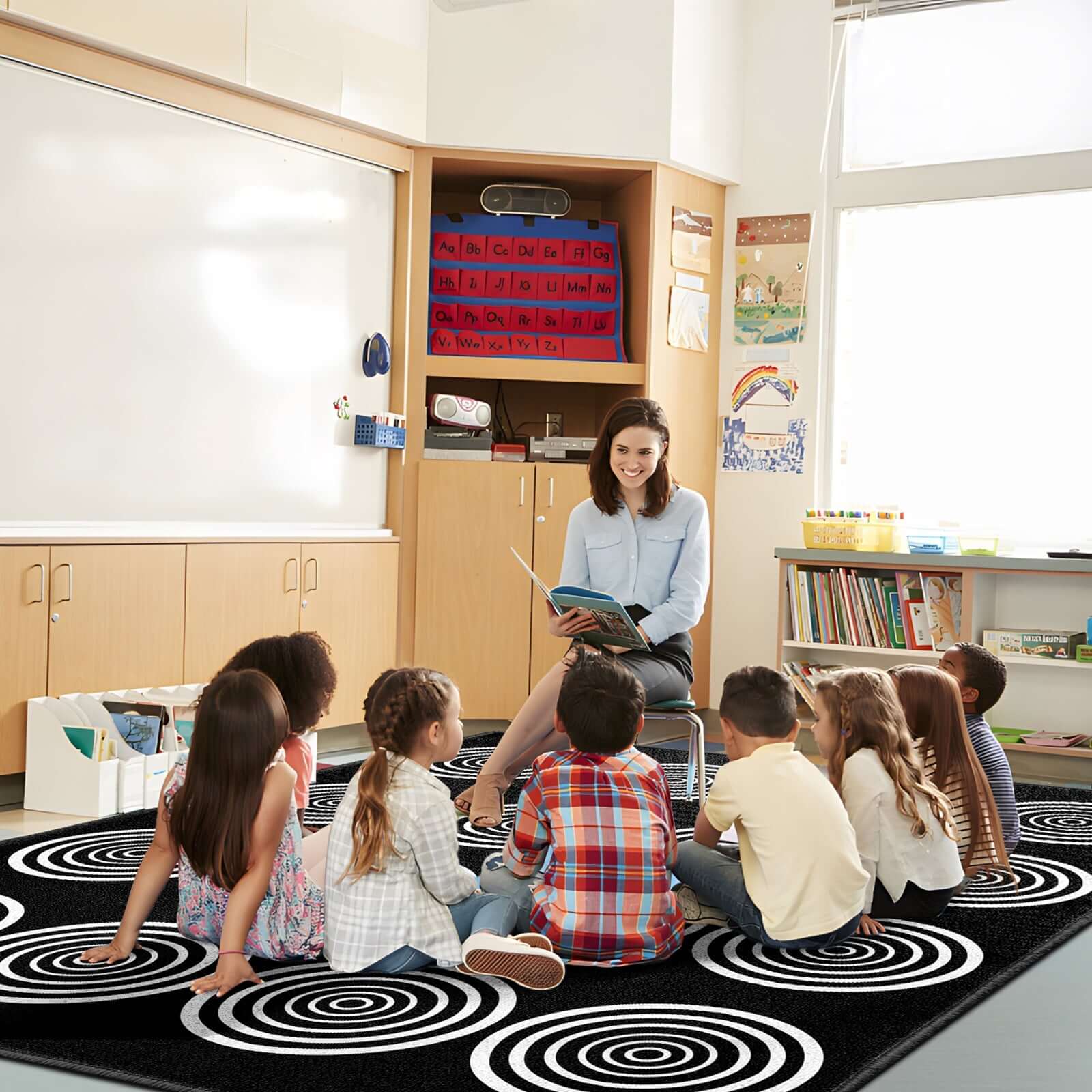The Science of Literacy-Rich Environments
Research consistently demonstrates that literacy-rich environments have a significant impact on what goes on in the classroom and set the stage for interactions with a wide variety of genres.
The literacy-rich environment emphasizes the importance of speaking, reading, and writing in the learning of all students.
This involves the selection of materials that will facilitate language and literacy opportunities; reflection and thought regarding classroom design; and intentional instruction and facilitation by teachers and staff.
Creating Meaningful Print Connections
Each letter of the alphabet is displayed on its own book, complete with charming images that represent the letter's sound.
This approach to environmental print helps children make crucial connections between oral and written language while developing phonemic awareness in an engaging, visual format.
Essential Types of Literacy-Focused Classroom Rugs
Reading Corner Rugs: The Heart of Literacy Spaces
Creating a cosy comfy space that feels safe is imperative if you want to encourage kids into the reading corner and get them to stay there long enough to read a book.
Reading rugs serve as the foundation for independent reading time, group story sessions, and quiet literacy activities.
Popular reading corner rug features include:
- Soft, cushioned surfaces for extended sitting comfort
- Defined reading spaces that encourage focus and concentration
- Book-themed designs that reinforce the joy of reading
- Circular or oval shapes that facilitate group discussions
- Corner-friendly designs that maximize classroom space efficiency
Alphabet and Phonics Learning Rugs
Alphabet classroom rugs create immediate visual connections between letters, sounds, and vocabulary.
From apples to violins, each illustration provides a talking point for vocabulary expansion. These educational floor coverings support multiple learning objectives simultaneously:
- Letter recognition through large, clear alphabet displays
- Phonemic awareness via picture-sound associations
- Vocabulary development through rich visual imagery
- Spatial learning as students navigate letter placement
- Early childhood education fundamentals in an engaging format
Interactive Storytelling Rugs
Transform story time into an immersive experience with rugs designed specifically for narrative engagement.
Transform any space into a cozy corner for reading and storytelling, where the branches of the tree shelter you in literary comfort.
Design Elements That Enhance Literacy Learning
Visual Appeal and Educational Function
Rich Color Palette: Set against a deep blue background, the colorful squares pop, creating an inviting and stimulating visual experience.
The aesthetic design of literacy rugs plays a crucial role in creating environments where students want to spend time with books and reading activities.
Key design considerations include:
- High-contrast colors that support visual processing
- Clear, readable fonts that model proper letter formation
- Thematic coherence that supports curriculum integration
- Age-appropriate imagery that resonates with target learners
- Durable construction that withstands daily classroom use
Supporting Print-Rich Environment Goals
Creating a literacy-rich environment aims to integrate literacy elements throughout the classroom so students are fully immersed in literacy throughout the day.
Classroom rugs contribute to this goal by providing consistent, accessible print experiences that students encounter naturally during daily activities.
Implementation Strategies for Maximum Literacy Impact
Creating Designated Reading Zones
Arrange the area with brightly colored carpets and comfortable chairs to create a fun space for kids to spend time with classroom materials.
Strategic rug placement helps establish clear literacy zones within the broader classroom environment.
Effective reading zone setup includes:
- Central rug placement for easy teacher-student interaction
- Adequate lighting to support reading activities
- Accessible book storage integrated with rug positioning
- Flexible arrangement that accommodates various group sizes
- Quiet designation separate from high-activity areas
Integrating Technology and Traditional Literacy
Modern literacy environments benefit from technology integration. Our colorful and vibrant classroom alphabet/habitat rugs come to life in 3D Augmented Reality with help from the Rugs alive™ Plus mobile app.
This innovative approach demonstrates how traditional classroom rugs can bridge analog and digital learning experiences.
Supporting Diverse Learning Needs
Equip a section of your classroom library with books formatted for the vision-impaired or multi-lingual books for English Language Learners.
Similarly, literacy rugs should accommodate diverse learning styles and abilities through thoughtful design choices.
Research-Based Benefits for Literacy Development
Foundation Skills Development
Because literacy-rich environments can be individualized to meet student's needs, teachers are able to create both independent and directed activities to enhance understanding of concept of print and word, linguistic and phonemic awareness, and vocabulary development.
Classroom rugs specifically support:
- Concept of print understanding through visual text exposure
- Phonological awareness via sound-symbol connections
- Vocabulary expansion through contextual word exposure
- Spatial organization of letters and words
- Social literacy skills during group reading activities
Long-term Academic Impact
Reading is a fundamental skill that defines the academic successor failure of students. As noted by Barbara Foorman from the University of Texas, Houston Medical School, "88 percent of students who were poor readers in first grade were poor readers in fourth grade".
This statistic underscores the critical importance of establishing strong literacy foundations early, making classroom rug selection a significant educational investment.
Practical Selection and Maintenance Guidelines
Quality Indicators for Educational Rugs
When selecting literacy-focused classroom rugs, prioritize:
- Educational integrity that aligns with curriculum standards
- Durability ratings appropriate for classroom use
- Safety certifications including fire resistance
- Maintenance requirements that fit school cleaning protocols
- Size specifications that accommodate intended activities
Budget-Conscious Approaches
This rug ships factory direct from Georgia. Direct manufacturer relationships often provide better value for educational institutions. Consider also:
- Multi-purpose designs that serve various literacy functions
- Modular options like carpet squares for flexibility
- Seasonal themes that can be rotated throughout the year
- Community partnerships for funding educational materials
- Grant opportunities specifically for literacy environment enhancement
Professional Development and Training
Teacher Preparation for Literacy Rug Implementation
This involves the selection of materials that will facilitate language and literacy opportunities; reflection and thought regarding classroom design; and intentional instruction and facilitation by teachers and staff.
Successful literacy rug implementation requires professional development focused on:
- Environmental print theory and practical application
- Differentiation strategies for diverse learners
- Assessment techniques for monitoring literacy progress
- Classroom management in flexible seating environments
- Curriculum integration across subject areas
For additional insights into creating effective learning environments, explore the comprehensive research available through the Reading Rockets organization, which provides evidence-based strategies for literacy education.
Measuring Success in Literacy-Rich Environments
Observable Indicators of Effective Implementation
Successful literacy rug programs demonstrate:
- Increased voluntary reading during independent time
- Enhanced participation in group literacy activities
- Improved letter and sound recognition in assessment
- Greater comfort with print-rich environments
- Positive attitudes toward reading and literacy learning
Long-term Benefits for reading comprehension
Students who experience well-designed literacy environments show sustained improvements in:
- Vocabulary development across content areas
- Reading fluency and comprehension skills
- Writing confidence and expression
- Critical thinking abilities
- Lifelong learning habits and interests
Creating Collaborative Learning Opportunities
Group Dynamics and Social Literacy
Creating a space for partner or group reading is a great way to encourage collaborative learning. Literacy rugs facilitate social learning experiences that build communication skills alongside reading abilities.
Effective group configurations include:
- Reading partnerships for peer support
- Small group instruction for targeted intervention
- Whole class discussions about shared texts
- Cross-age mentoring programs
- Family reading events that extend learning home
Future Trends in Literacy Environment Design
Innovation in Educational Floor Coverings
The evolution of classroom rugs continues to reflect advances in educational technology and pedagogical understanding. Emerging trends include:
- Interactive surfaces that respond to touch
- Sustainable materials that support environmental education
- Customizable designs that reflect community diversity
- Multi-sensory elements for enhanced learning
- Integrated assessment tools for real-time feedback
Conclusion: Investing in Literacy Success
Creating a literacy-rich environment through thoughtful classroom rug selection represents a strategic investment in student success.
These foundational tools provide daily opportunities for meaningful print engagement, support diverse learning styles, and create the comfortable, welcoming spaces where lifelong readers are born.
The evidence overwhelmingly supports the value of print-rich environments in developing essential literacy skills.
By carefully selecting and implementing educational classroom rugs that align with research-based best practices, educators can create dynamic learning spaces that inspire, engage, and nurture the next generation of confident readers and writers.
Whether establishing a new literacy program or enhancing existing resources, quality classroom rugs serve as the foundation for transformative educational experiences that extend far beyond the classroom walls.




Leave a comment
This site is protected by hCaptcha and the hCaptcha Privacy Policy and Terms of Service apply.